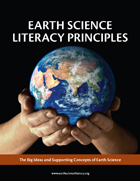If you’re clueless about petrology, paleobiology and plate tectonics, the National Science Foundation (NSF) and the Earth Science Literacy Initiative (ESLI) have just released a free pamphlet offering a concise primer on what all Americans should know about the Earth sciences.
Funded by the National Science Foundation and compiled over the last year by ESLI, the booklet represents an attempt to gather and codify the underlying understandings of Earth sciences into a succinct document that will have broad-reaching applications in both public and private arenas.
“The Earth Science Literacy framework document of ‘Big Ideas’ and supporting concepts was a community effort representing the current state-of-the-art research in Earth sciences,” said Michael E. Wysession, Ph.D., chair of ESLI and associate professor of geophysics in the Department of Earth and Planetary Sciences in Arts & Sciences at Washington University in St. Louis.

More information on the Earth Science Literacy Initiative and a downloadable version of the free booklet can be found at www.earthscienceliteracy.org.
Covers essential information
The new Earth Science Literacy Principles establish nine “Big Ideas” and 7-10 supporting concepts for each, which together cover the essential information that everyone should know about the Earth sciences.
The resulting Earth Science Literacy framework will also become part of the foundation, along with similar documents from the ocean, atmosphere and climate communities, of a larger geoscience “Earth Systems Science” literacy effort.
The scope of the new ESLI Earth Science Literacy Principles spans a wide variety of research fields that are funded through the NSF-EAR program.
These fields include geobiology and low-temperature geochemistry, geomorphology and land-use dynamics, geophysics, hydrologic sciences, petrology and geochemistry, sedimentary geology and paleobiology, and tectonics.
The project included a two-week online workshop with more than 350 participants and multiple revisions supervised by a dedicated organizing committee of a dozen Earth scientists and educators.
“It was written, evaluated, shaped and revised by the top scientists working in Earth science,” Wysession said. “Because of its validity, authority and succinct format, the ESLI document will be influential in a wide variety of scientific, educational and political domains.
“New textbooks and curricula are already being developed using it, and future governmental legislation will be guided by it.”